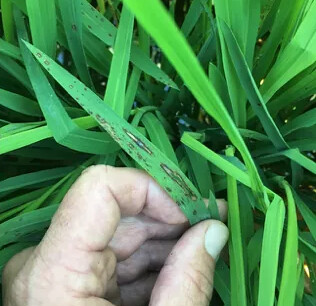Put your scouting hat on: SW corn borers, rice disease incidents on the rise
By Mary Hightower
U of A System Division of Agriculture
June 30, 2017
Fast facts:
- Southwestern corn borer trap counts up in some locations, scouting recommended
- Rice growers need to keep eyes peeled for blast, sheath blight.
(283 words)
(Download this story in MS Word here.)
(newsrooms: with downloadable art:
Rice blast: www.flickr.com/photos/uacescomm/35487019791
Filers of sheath blight: www.flickr.com/photos/uacescomm/28832415922, www.flickr.com/photos/uacescomm/4798955399
Corn borer moths: www.flickr.com/photos/uacescomm/34806429403
Charts showing trap counts from four counties: www.flickr.com/photos/uacescomm/35575863476, www.flickr.com/photos/uacescomm/35575863616, www.flickr.com/photos/uacescomm/35228567490)
STUTTGART, Ark. – Arkansas crop producers are being encouraged to be in scouting mode as the number of incidents of rice diseases and some insect pests rise.
Traps set by extension personnel as bellwethers for crop pest populations have seen high numbers in some areas.
“We are seeing a big jump in southwestern corn borer trap catches, particularly in the area around Brinkley and Wheatley,” said Glenn Studebaker, extension entomologist for the University of Arkansas System Division of Agriculture. “One trap hit more than 1,000 moths for a single week.”
Studebaker said the threshold to begin treating southwestern corn for borers is 100 moths per trap per week. Once hatched, corn borer caterpillars feed on leaves for a few days before burrowing into the cornstalk. At that point, “an insecticide application will not control them.”
For recommended application, contact your county agents.
Rice blast, blight
Yeshi Wamishe, extension plant pathologist with the U of A System Division of Agriculture, said she’s received reports of sheath blight in rice and now is a good time to be scouting for rice blast.
“So far, sheath blight has been reported on Lakast and CL153 and blast has been reported on Jupiter and Lakast,” she said.
Because managing rice diseases can be an expensive proposition, Wamishe recommends scouting and planning ahead to minimize any losses to disease.
“Remember, fungicides are most beneficial in well managed fields,” she said. “If you’ve planted a blast susceptible variety in an historically blast-prone field, you need to plan ahead for fungicide protection. The same is true for false smut or kernel smut.
“Timing is everything,” she said. For more information on fungicide timing for selected rice diseases, see: http://bit.ly/2srinQz or contact your county extension office.
To learn more about row crop pests in Arkansas, contact your local Cooperative Extension Service agent or visit www.uaex.uada.edu.
About the Division of Agriculture
The University of Arkansas System Division of Agriculture’s mission is to strengthen agriculture, communities, and families by connecting trusted research to the adoption of best practices. Through the Agricultural Experiment Station and the Cooperative Extension Service, the Division of Agriculture conducts research and extension work within the nation’s historic land grant education system.
Pursuant to 7 CFR § 15.3, the University of Arkansas System Division of Agriculture offers all its Extension and Research programs and services (including employment) without regard to race, color, sex, national origin, religion, age, disability, marital or veteran status, genetic information, sexual preference, pregnancy or any other legally protected status, and is an equal opportunity institution.
# # #
Media Contact: Mary Hightower
Dir. of Communication Services
U of A Division of Agriculture
Cooperative Extension Service
(501) 671-2126
mhightower@uada.edu
Related Links
